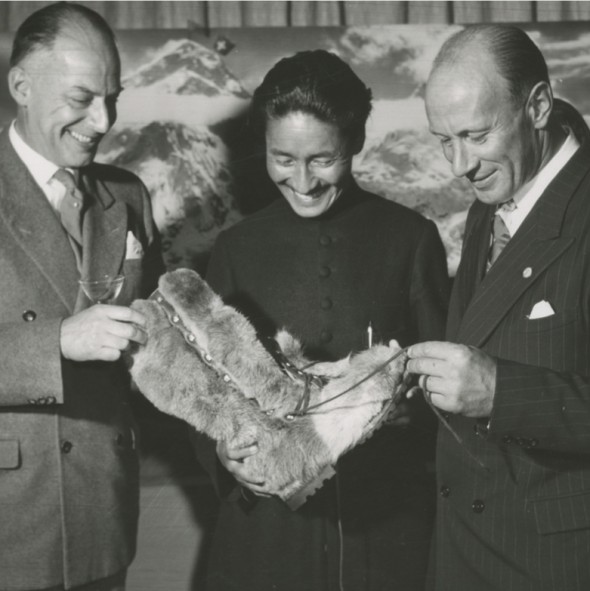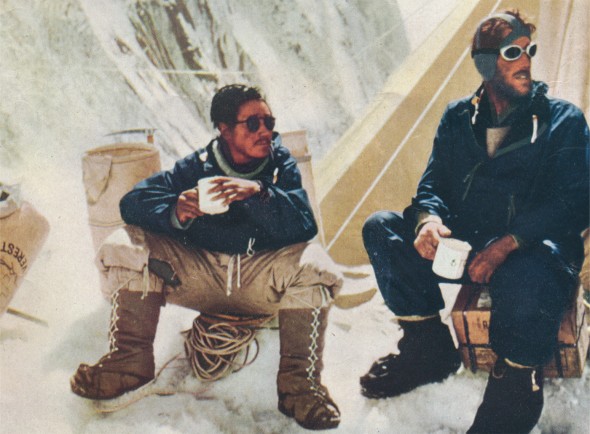
Sixty years ago, Sherpa Tenzing Norgay and Sir Edmund Hillary took the first steps on top of Mount Everest.
Tenzing Norgay, his face covered with an oxygen mask, stretches his right arm toward the sky, triumphantly waving his axe on the Mount Everest summit. Against the sky, flags of Britain, Nepal, the United Nations, and India flap in the freezing wind. It is 11:30 AM local time, on May 29, 1953, when the Nepalese Sherpa and the New Zealand beekeeper/mountaineer Edmund Hillary finally take the first steps on top of the world. An incredible achievement immortalized by Hillary’s iconic photo of Tenzing. After a joyful hug, the two men don’t spend more than 15 minutes on the summit before they are forced to descend due to low oxygen supply, but those minutes are enough to turn them into heroes.
Tenzing and Hillary were part of a British team led by Colonel John Hunt, consisting of a dozen climbers, 35 Sherpa guides—the Nepalese people living in the shadow of the mountain—and 350 porters carrying 18 tons of food and equipment. The expedition that was to achieve the impossible was hardly the first to try. Ever since Mount Everest, towering 29,035 feet above the ocean along the border of Nepal and Tibet, was declared the world’s highest mountain in 1852, adventurers have dreamt of making it to the Himalayan peak. It wasn’t until 1921 when the forbidden kingdom of Tibet first opened its borders, that it first became a realistic feat. Many tried, and many fell victim to the mountain’s treacherous crevices or freezing winds. Others suffered from mountain sickness, a dangerous condition that appears when the high altitude prevents the brain from receiving enough oxygen. It is still debated whether George Leigh Mallory and Andrew “Sandy” Irvine actually made it to the top during their famous climb in 1924. But since neither of them made it down alive, that is something nobody will probably ever know.
When the British expedition set out in 1953, Hillary had already attempted to conquer the mountain in 1951 and again in 1952. For Sherpa Tenzing, this was his seventh Everest expedition. The previous year, he had been part of a Swiss team that opened a new route from the southern side and settled with a new record by reaching 28,200 feet. For a climber who is challenging nature as well as his own body, equipment is key, so thankfully the Swiss also provided Tenzing with gear and shoes. And so when he finally reached the summit after years of preparation, Tenzing was wearing a pair of Bally’s Reindeer Himalaya boots. To celebrate the 60-year anniversary of the heroic ascent, the Swiss shoe manufacturer is now launching a collection inspired by that boot.

“This was actually something we discussed when we first arrived at Bally. Being associated with this very expedition and this connection with innovation was something we wanted to explore and make people aware of. It was quite fascinating to discover the imagery in the archive and watch the film footage,” says Michael Herz, who, together with Graeme Fidler, took over as the company’s creative directors in 2010.
Although the Reindeer-Himalaya boot brings to mind the northern-dwelling animal grazing the majestic mountain chain, the 1953 expedition is probably as close to the Mount Everest summit as a reindeer has ever been.
“The boot was made of reindeer fur, which is a hollow fiber fur that gives super insolation and has a natural water repellent coating,” says Herz.
“Ultimately, it is known as the highest performing fur that you can possibly use for that sort of icy environment,” says Fidler.
The boot also sports a new hook lace-up system and a newly developed rubber sole. When the Bally team decided to do a capsule collection in celebration of the anniversary, they even found the German manufacturer of the original hook laceup system. Studying the technically advanced original boot pushed them to further develop the collection.
“That gave us the energy and inspiration to do another level of research and development. We were inspired by the story of the anniversary and the scale of the exploration. But ultimately we had to make a shoe for tomorrow,” says Fidler.
The original Reindeer-Himalaya boot took its bearer all the way up to the roof of the world. Before descending, Sherpa Tenzing buried some sweets in the snow as a Buddhist offering to the gods. Later, Hillary described the summit as another goody—“a symmetrical, beautiful snow cone.” The news of the climb quickly spread across the world. Hillary, who lived to be 88 years old, and Hunt were knighted by Queen Elizabeth II, while Tenzing received the George Medal of Britain. Tenzing passed away in West Bengal, India, in 1986 at the age of 71—but his legacy lives on. Today, Bally might be far more associated with high fashion than high climbing, but just how far the new interpretation of Tenzing’s shoe will go is up to the wearer.
“It could very well end up in St. Moritz. But it could just as well end up on Madison Avenue on a snowy winter day,” says Fidler.
Text by Katarina Mattson

